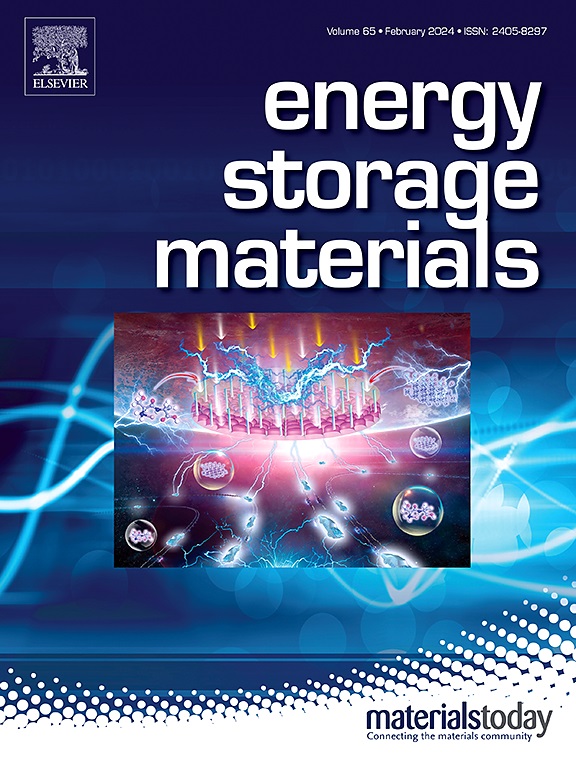High-efficiency NaCl presodiation agent for sodium-ion batteries
IF 20.2
1区 材料科学
Q1 CHEMISTRY, PHYSICAL
引用次数: 0
Abstract
In the ordinary sodium-ion batteries, irreversible sodium loss during the initial cycle is inevitable, significantly reducing the initial Coulombic efficiency and operational lifespan. In this work, sodium chloride (NaCl) was developed as a low-cost, non-toxic and high-efficient presodiation agent for Na-ion batteries. The facilely prepared NaCl/Ketjen Black composite can deliver a presodiation capacity of 457 mAh g−1 below 4.2 V. Innovatively, instead of direct cathode incorporation, NaCl is applied as a presodiation layer on commercial polypropylene separators, ensuring homogeneous sodium compensation while avoiding structural damage to the Na3V2(PO4)3 cathode. In Na3V2(PO4)3||hard carbon full cells, this approach fully offsets initial sodium loss, achieving a 46.8 % increase in initial discharge capacity (115 mAh g−1) and an ideal 100 % initial Coulombic efficiency. Mechanistic studies confirm NaCl’s irreversible decomposition without harmful Cl2 byproducts, while residual Cl species do not impede charge transfer. The strategy boosts energy density by 29 % (186 Wh kg−1) and demonstrates scalability for practical applications. This work presents a cost-effective and industrially scalable strategy to mitigate irreversible sodium loss, advancing the development of high-energy-density and long-cycle-life sodium-ion batteries.


钠离子电池用高效NaCl预沉淀剂
普通钠离子电池在初始循环过程中不可避免地会出现不可逆的钠离子损耗,这将大大降低电池的初始库仑效率和使用寿命。在本工作中,氯化钠(NaCl)是一种低成本、无毒、高效的钠离子电池预沉淀剂。制备的NaCl/Ketjen Black复合材料在4.2 V下可提供457 mAh g−1的预沉淀容量。创新之处是,在商用聚丙烯分离器上使用NaCl作为预沉淀层,而不是直接引入阴极,既保证了均匀的钠补偿,又避免了对Na3V2(PO4)3阴极的结构破坏。在Na3V2(PO4)3||硬碳全电池中,该方法完全抵消了初始钠损失,实现了初始放电容量增加46.8% (115 mAh g−1)和理想的100%初始库仑效率。机理研究证实NaCl的不可逆分解无有害的Cl2副产物,而残留的Cl种不妨碍电荷转移。该策略将能量密度提高了29% (186 Wh kg−1),并证明了实际应用的可扩展性。这项工作提出了一种具有成本效益和工业可扩展的策略,以减轻不可逆的钠损失,推进高能量密度和长循环寿命钠离子电池的发展。
本文章由计算机程序翻译,如有差异,请以英文原文为准。
求助全文
约1分钟内获得全文
求助全文
来源期刊

Energy Storage Materials
Materials Science-General Materials Science
CiteScore
33.00
自引率
5.90%
发文量
652
审稿时长
27 days
期刊介绍:
Energy Storage Materials is a global interdisciplinary journal dedicated to sharing scientific and technological advancements in materials and devices for advanced energy storage and related energy conversion, such as in metal-O2 batteries. The journal features comprehensive research articles, including full papers and short communications, as well as authoritative feature articles and reviews by leading experts in the field.
Energy Storage Materials covers a wide range of topics, including the synthesis, fabrication, structure, properties, performance, and technological applications of energy storage materials. Additionally, the journal explores strategies, policies, and developments in the field of energy storage materials and devices for sustainable energy.
Published papers are selected based on their scientific and technological significance, their ability to provide valuable new knowledge, and their relevance to the international research community.
 求助内容:
求助内容: 应助结果提醒方式:
应助结果提醒方式:


